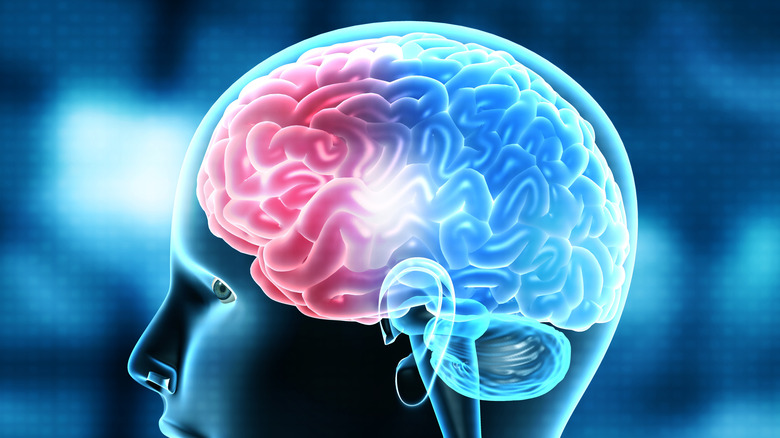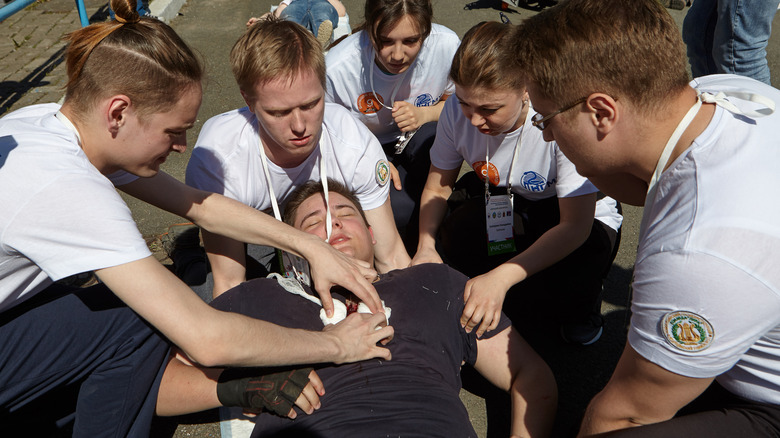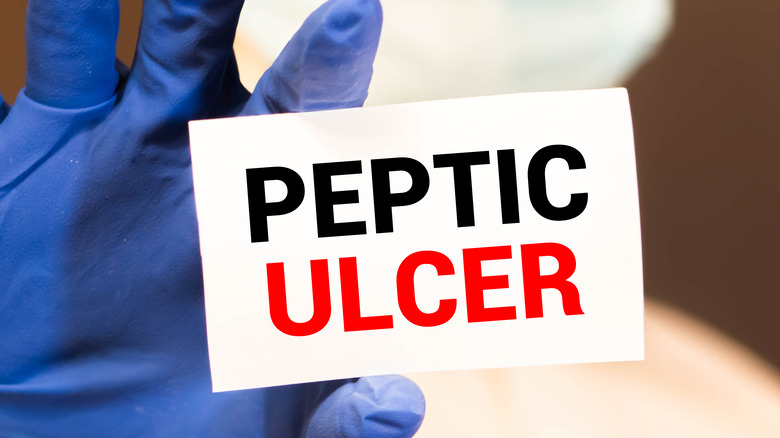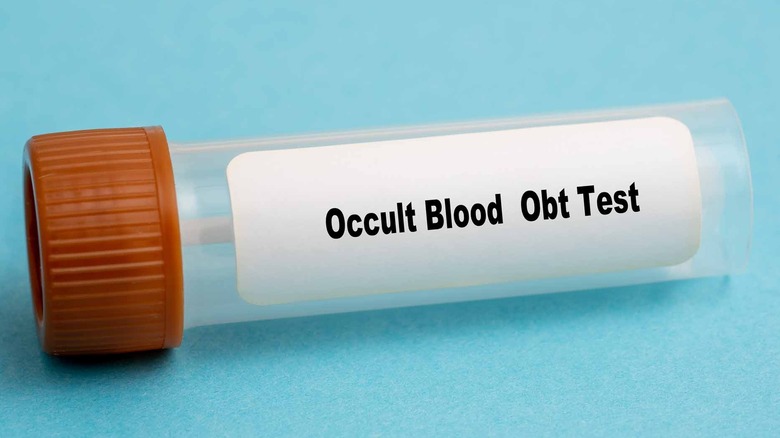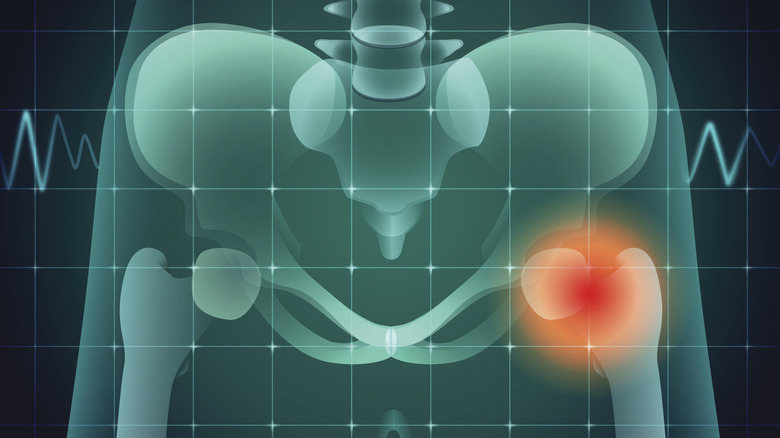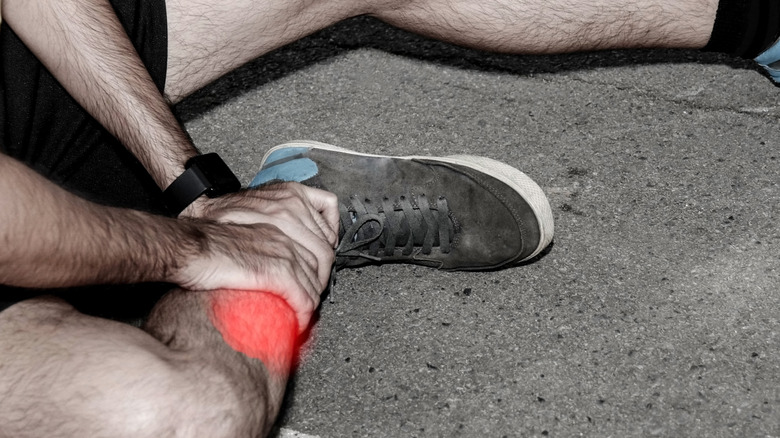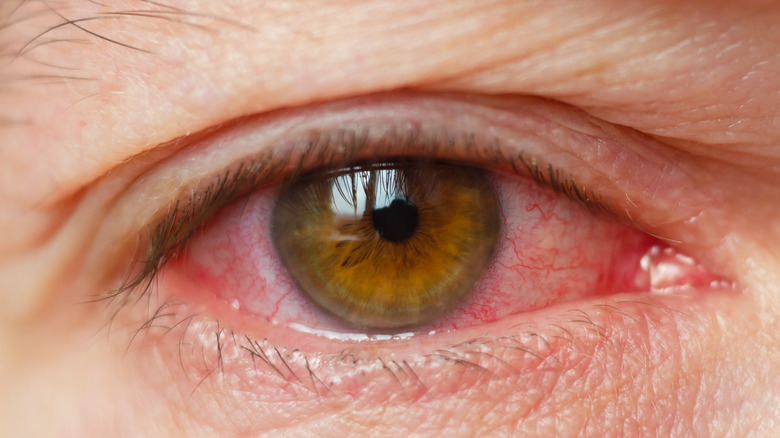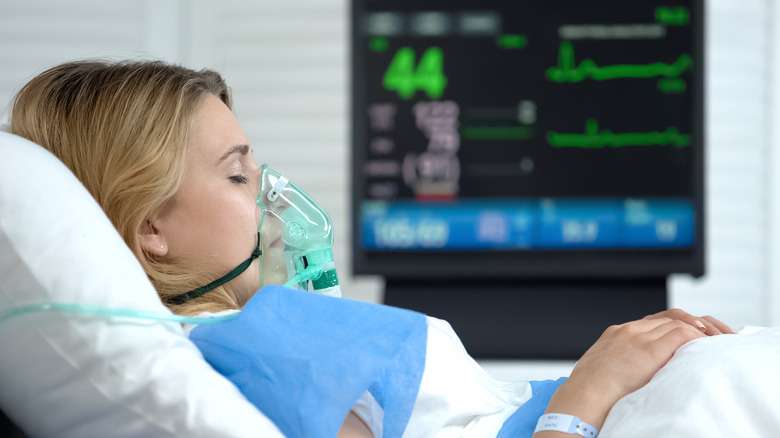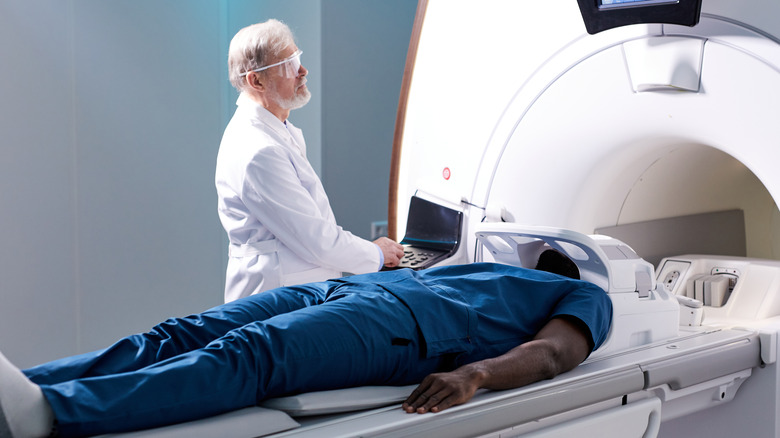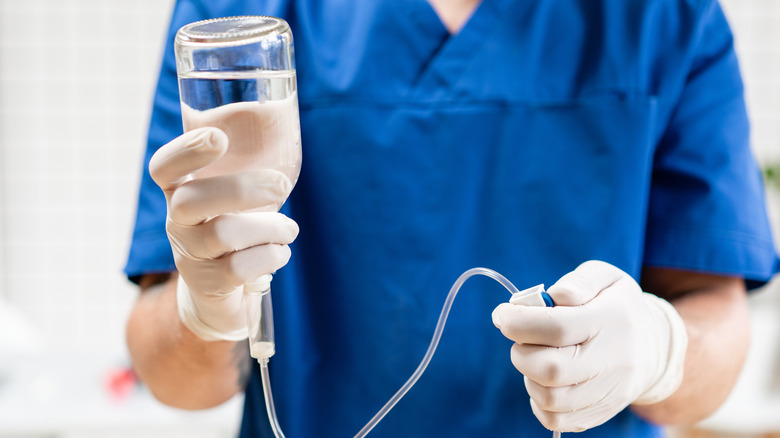Signs You May Have Internal Bleeding Explained
Unlike a visible wound on your skin, internal bleeding that occurs inside the body is easily overlooked, reports Medical News Today. Blood loss from damaged blood vessels (hemorrhaging) could cause a wide variety of symptoms, since blood permeates the entire body.
Internal bleeding is most often caused by traumatic injuries such as falls or auto accidents. At first, an injured person may not have any symptoms from internal hemorrhaging but may experience pain, notes the Merck Manual. In addition to the abdomen, chest, and intestines, bleeding can also occur near fractured bones, e.g., pelvic bones. Ultimately, signs of bleeding such as blood in the stool will be spotted. If a substantial amount of blood is lost, blood pressure may fall and cause the person to become light-headed or faint, or even experience life-threatening shock and slip into unconsciousness. In this emergency scenario, the person should be laid down with legs elevated until medical help arrives.
Per Healthline, other general causes of internal bleeding include GI conditions (e.g., peptic ulcer, colitis), genetic disorders such as hemophilia (inability of blood to clot), hypertension, and some medications such as blood thinners and aspirin. A ruptured aneurysm (bulge in blood vessel due to weakened blood vessel wall), ectopic pregnancy (outside the uterus), and surgery (persistent bleeding) are more urgent causes. Other locations where internal bleeding can occur include the joints, muscles, brain, eyes, and throat (via the National Hemophilia Foundation).
Risk factors and general signs of internal bleeding
While the signs and symptoms of internal bleeding are dependent upon the location and severity of the bleed, some general signs of blood loss include dizziness, fatigue, weakness, nausea, difficulty breathing, and a cool sensation when the skin is touched (via the Cleveland Clinic).
If untreated, extensive bleeding can cause organ failure, rapid heart rate, disorientation, chest pain, and seizures. Some people with a considerable loss of blood may go into shock, notes Healthline. When in shock, a person may become weak and lethargic, and may experience sweaty skin. In some individuals, a sudden drop in blood pressure may occur upon standing up quickly, causing dizziness and loss of balance. Other general signs of internal hemorrhaging include acute headache, intense stomach pain, vomiting, and diarrhea. Severe vision problems, numbness, and weakness on one side of the body may also suggest an internal bleed.
According to GoodRx Health, certain factors can increase the risk of internal bleeding. For example, while blood thinners such as Plavix and Warfarin prevent abnormal clotting, they can cause excessive bleeding from trauma. Similarly, a person with the genetic condition hemophilia may bleed extensively when injured. Over-the-counter pain medications such as ibuprofen and other NSAIDs can increase the risk of bleeding stomach ulcers. The stomach lining can also be injured by alcohol, smoking, and illicit drugs (per Healthline). Unusually pale skin, anxiety, confusion, or drowsiness are additional signs of internal bleeding.
Bleeding in the brain
A brain bleed typically occurs suddenly and causes brain damage that can be fatal, notes the Cleveland Clinic. Hemorrhaging in the brain due to burst blood vessels disrupts the flow of oxygen-rich blood. Lack of oxygen causes brain cells to die, potentially leading to physical and cognitive impairment. Brain bleeds occur either between the skull and brain tissue or inside the brain tissue itself. In the former, the bleeding occurs someplace between three membranes that separate the skull from brain tissue: the dura mater (outermost), arachnoid, and pia mater (innermost). Three types of bleeding occur among these three membranes. In order of proximity to the skull, an epidural bleed occurs closest to the skull, followed by subdural hemorrhage. Subarachnoid hemorrhage occurs closest to the brain tissue. Within the brain matter, two types of bleeds can develop: intracerebral hemorrhage and intraventricular hemorrhage.
While brain hemorrhaging is more common in older adults, it can affect people of all ages, and is second only to blood clots as a leading cause of stroke. Some causes of brain bleeds include head trauma, high blood pressure, brain aneurysms, bleeding disorders, and treatment with blood thinners.
Some people with brain hemorrhaging may experience a severe, sudden headache or vision or hearing changes, per Healthline. Others may have difficulty speaking, writing, swallowing, chewing, or staying alert. Additional signs include loss of balance or coordination, tingling in the hands and feet, numbness and weakness on one side of the body, and loss of consciousness.
Bleeding in the chest
Bleeding and accumulation of blood in the space between the chest wall and the lung is called a hemothorax, reports Medical News Today. Traumatic injury to the chest area is the leading cause of hemothorax. For example, bleeding in the chest may occur in a person injured in an auto accident if a broken rib penetrates the lungs. Non-penetrating blunt trauma from the force of the impact may cause bleeding in the chest area as well. Paramedics routinely assess the lungs of accident victims for signs of bleeding.
Apart from trauma, hemothorax can also occur spontaneously in association with certain health conditions. These conditions include lung infections (e.g., tuberculosis), lung cancer, blood clot in the lungs (pulmonary embolism), blood clotting defects (e.g., hemophilia, use of blood thinners), and death of lung tissue. Blood vessel damage from surgery or placement of a venous catheter may also cause bleeding.
After an injury, bleeding within the chest cavity may initially go unnoticed (via WebMD). Signs of bleeding to look for include chest pain, rapid heart rate, rapid and shallow breathing, pale and clammy skin, and anxiety or uneasiness. If shock sets in, the victim may become nauseous, fatigued, or confused. Medical emergency assistance should be summoned in cases of dizziness/lightheadedness, fever, cough, heaviness in the chest, shortness of breath, or intense pain in the chest, neck, jaw, shoulder, or arm.
Upper gastrointestinal bleeding
As in cases of head and chest bleeding, abdominal bleeding can result from blunt trauma, most often damaging the spleen and liver (via Science Direct). However, according to the Mayo Clinic, peptic ulcers are the leading cause of bleeding in the upper portion of the GI tract, which includes the esophagus, stomach, and the first part of the small intestine (the duodenum).
Peptic ulcers occur when stomach acid wears away the lining of the stomach or duodenum, primarily as a result of bacterial infection or use of anti-inflammatory medications. Excessive upper GI bleeding may also emanate from tears in the lining of the esophagus (referred to as Mallory-Weiss tears) often caused by excessive alcohol consumption. Bleeding in the esophagus can occur as a result of abnormally enlarged veins or inflammation related to severe liver disease and GERD (gastroesophageal reflux disease), respectively, as well.
Per GoodRx Health, people with abdominal bleeding may notice blood in their urine, or may be unable to pass gas or have a bowel movement. They may also experience pain in the stomach, abdomen, pelvis, or flank. Another sign of bleeding is abdominal bruising, particularly near the navel or sides of the abdomen.
Lower gastrointestinal bleeding
Like upper GI bleeding, bleeding in the lower GI tract is also, for the most part, a symptom of an intestinal disorder (via WebMD). Bleeding may not be serious, as is usually the case when hemorrhoids bleed. Bright red blood in the stool, in the toilet, or on toilet paper is often a sign of ruptured hemorrhoids. Other general signs of intestinal bleeding include bloody or black tar-like stools, dark blood blended in the stool, and vomiting bright red blood or blood that looks like coffee grounds. Anemia and associated fatigue, weakness, and pale skin are additional signs of blood loss. Sometimes, bleeding is not visible. Instances of hidden (occult) blood loss can be detected through testing.
Intestinal bleeding may occur in people with GI disorders such as diverticulosis and inflammatory bowel disease (IBD), notes the Mayo Clinic. Diverticulosis is characterized by bulging pouches along the GI tract that can become inflamed or infected (diverticulitis), while IBD includes ulcerative colitis and Crohn's disease. Other GI conditions such as benign or cancerous tumors, as well as colon polyps, can cause damage to the gut lining that may result in bleeding. Rectal bleeding can also result from anal fissures (splits in the lining of the anus) and proctitis (inflammation of the rectum).
Bleeding in a joint
Per WebMD, bleeding in a joint often occurs after an injury. Synovial joints link two bones that move against each other and include the hips, knees, shoulders, elbows, wrists, hands, ankles, and feet. Blood spilling from a ruptured artery mixes with synovial fluid and permeates the joint area. This mixture of blood and joint fluid can damage soft issue, bone, ligaments, or cartilage. Severe damage to the joint can cause swelling and pain, and even arthritis if the injury is recurrent.
People that take anticoagulant medications (blood thinners) or have a deficiency of vitamin K are also at risk of joint bleeding. Advanced liver or kidney disease, blood vessel damage, nerve conditions, tumors, and bleeding disorders such as hemophilia contribute to joint bleeding as well. In fact, according to the National Hemophilia Foundation (NHF), internal bleeding in people with hemophilia occurs most often in a joint, and particularly in the joints of the ankles, elbows, and knees. In addition to swelling and pain, signs of joint bleeding include a tingling or bubbling feeling in the joint, limited ability to move a joint, and warmer skin near the joint. Moreover, a child with joint bleeding may be observed avoiding the use of the affected arm or leg.
Bleeding into muscles
Though bleeding into muscles can occur without a known cause, traumas such as a blow, a sprain, or even an injection can trigger a muscle to bleed that may lead to considerable loss of blood in the body, via the National Hemophilia Foundation (NHF).
As blood accumulates in a closed muscle space, it significantly increases the pressure within the space to dangerously high levels, reports WebMD. This compromises nutrient blood flow to the affected tissues that can result in severe damage. Symptoms such as tightness, bruising, and a chronic deep pain in an arm or leg may occur. If untreated, this phenomenon (known as compartment syndrome) can cause permanent injury, and may even be life-threatening.
The prevalence of muscle bleeding among people with hemophilia is second only to joint bleeding, notes Science Direct. In fact, bleeding into muscles is a hallmark of hemophilia, and frequently involves symptoms of compartment syndrome. In general, signs and symptoms associated with muscle bleeding include pain, aching, swelling, or tightness in the muscle (per the NHF). Some people with muscle bleeding may develop a limp, or they may notice that the skin around the bleeding site is warm. Others may experience numbness or tingling, or abnormally large veins in the affected arm or leg. An aversion to using the affected arm or leg may also be suggestive of a muscle bleed.
Bleeding in the eye
Per the National Hemophilia Foundation (NHF), bleeding inside the eye is a serious condition that, if prolonged, can lead to permanent loss of vision. It can result from eye trauma or occur without a known cause.
Some types of eye bleeds develop deep within the eye and are not visible at the eye surface (via Medical News Today). For example, bleeding can occur in the transparent part of the eye known as the vitreous (vitreous hemorrhage). Bleeding can also occur beneath the retina (subretinal hemorrhage) or in the space between the retina and a layer of pigmented cells known as the retinal pigment epithelium (submacular hemorrhage). People with eye hemorrhage may experience blurry vision or see floaters in their field of vision. Other signs include a red tint to the vision and scotomas (blind spots or partial vision loss).
Alternative causes of eye hemorrhage include conjunctivitis, eye tumors, contact lens use, laser eye treatment, and injury to the eye bones. In some people, an eye may bleed from the force of coughing, sneezing, vomiting, or exercising vigorously. The risk of eye bleeding is also increased by certain medications such as blood thinners (e.g., warfarin) and NSAIDs (e.g., aspirin). A number of medical conditions can cause eye bleeds as well, including hypertension, tumors, leukemia, and aneurysms. Eye hemorrhage can also occur in people with hemochromatosis (iron overload disease), thrombocytopenia (low blood platelets), and eye-related conditions such as posterior vitreous detachment (when the vitreous separates from the retina).
Complications of internal bleeding
Internal bleeding diminishes the flow of oxygen-rich blood to the body's organs (via StatPearls). Eventually, tissues in the body become starved of oxygen (hypoxia), resulting in the development of serious complications. In people with brain hemorrhage, lack of oxygen from inadequate blood supply for extended periods leads to tissue death. These individuals could potentially suffer from long-term impaired neurological and cognitive function as a result of tissue hypoxia.
Per Johns Hopkins Medicine, one particular type of brain bleed known as subarachnoid hemorrhage is a life-threatening type of stroke usually caused by a burst aneurysm and the subsequent leaking of blood into the space between the skull and the brain tissue. Some people with subarachnoid hemorrhage may become nauseous and confused, and have difficulty speaking. Others may experience a severe headache, stiff neck, double vision, drooping eyelid, light sensitivity, or coma.
Complications from a bleed in the GI tract include shock, anemia, and death (via WebMD). In general, complications resulting from internal bleeding include organ failure, seizures, coma, and death (per StatPearls). Re-bleeding and complications from hospitalization, like deep vein thrombosis (blood clots) and infections, may also occur.
Diagnosis of internal bleeding
Identifying the site of internal bleeding is often difficult, reports Medical News Today. A thorough medical history and physical exam are vital to help the doctor pinpoint the source of bleeding.
Imaging tests such as computed tomography (CT) or magnetic resonance imaging (MRI) scans usually play an important role in the diagnostic workup. An electrocardiogram (ECG), X-rays, and blood and urine tests may be helpful as well. Some signs of hemorrhaging, such as the presence of red blood cells or bilirubin in the cerebrospinal fluid, can be detected with a lumbar puncture (per StatPearls).
In some cases, a noninvasive diagnostic test called a FAST (focused assessment with sonography for trauma) scan is particularly useful in the assessment of abdominal bleeding. The FAST exam is highly reliable, and can be performed at the patient's bedside. Various types of endoscopies are also used to look for bleeding inside the body. These include bronchoscopy (lungs), cystoscopy (bladder), colonoscopy, and esophagogastroduodenoscopy or EGD (upper GI).
Treatment of internal bleeding
As described by Healthline, the treatment for minor or mild internal bleeding usually consists of rest and management of symptoms. Rest allows time for excess blood to be reabsorbed by the body and for inflammation to quell. Meanwhile, management of symptoms in a person with internal hemorrhage is determined by the location of the bleeding, the extent of the bleeding, and the individual's health status.
If the bleeding causes a decrease in the volume of fluid in the circulatory system (hypovolemia), IV fluids (including electrolytes, plasma, blood, and platelets) are administered to restore fluid volume as well as maintain oxygen supply to the cells of the body (via StatPearls).
While some cases of bleeding heal on their own, surgery may be required in more severe cases to halt the bleeding and clear away excess blood (per Healthline). Once the bleeding is resolved, treatment is directed towards repairing blood vessels and restoring their normal functioning.



